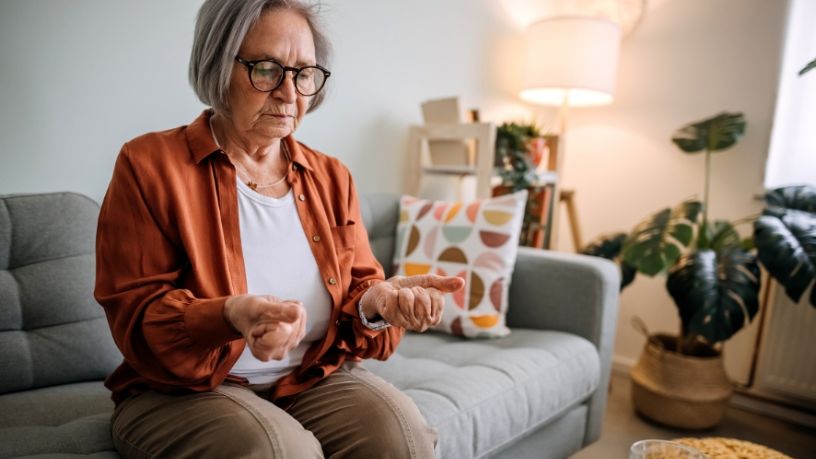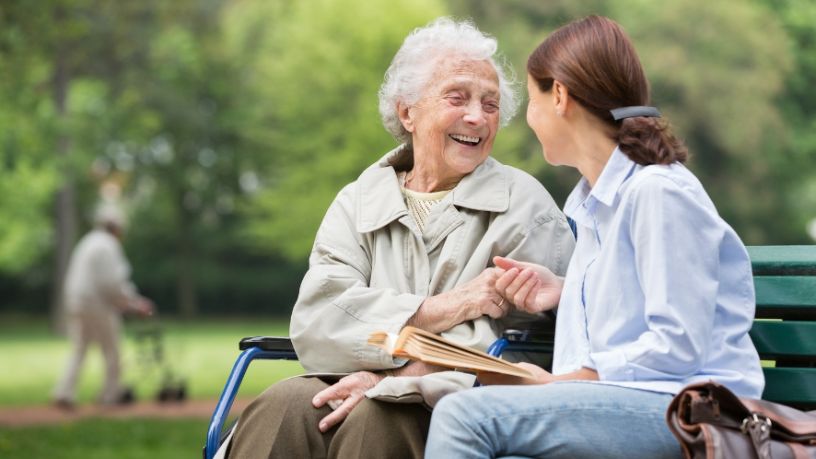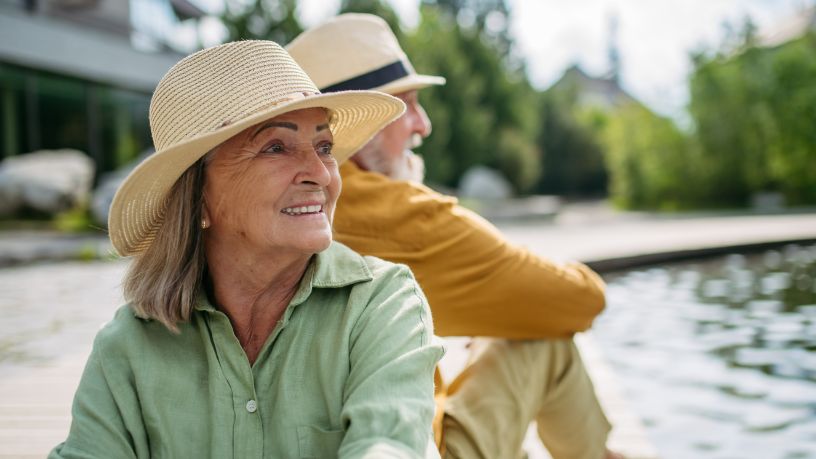On this page
Key takeaways
- Osteoarthritis causes pain and stiffness in joints which can make it hard to sleep.
- Gentle exercise can help decrease pain, potentially making it easier to sleep.
- Talk to your GP about what could help your symptoms of osteoarthritis and improve sleep quality.
Around 70% of people with osteoarthritis will experience some sort of sleep disturbance.1
Finding a comfortable position can often feel impossible, leading to frequent waking in the night and fatigue the next day.
Learn more about how this joint condition impact sleep and how to get a better night’s rest.
What is osteoarthritis?
Osteoarthritis2 is the most common form of arthritis diagnosed in Australia.
“Osteoarthritis can affect any of the movable joints, but most commonly your knees, hips or hands,” says Associate Professor Michelle Hall from the University of Sydney. “Our bodies are constantly in a state of repair and renewing. Osteoarthritis occurs when there’s an imbalance and there’s a greater breakdown as opposed to repair.
“Causes can include repercussions from a hip or ACL injury or being overweight. Women are also more likely to develop the condition, and age is also a common factor because as we get older our body can’t repair as quickly.”
Osteoarthritis can cause damage to the joint, bone spurs, inflammation of the tissue around the joint and ligament deterioration.
Common symptoms include pain and stiffness which over time can make everyday tasks, such as walking or standing difficult.
“Even something as simple as getting in and out of a car or putting on socks can be difficult and painful with osteoarthritis,” says Michelle.
How can osteoarthritis impact sleep?
The pain and discomfort caused by osteoarthritis can make falling asleep difficult. Certain positions may worsen pain, and it may feel impossible to find a pain-free way to drop off.
“When we do qualitative studies or interviews with people with osteoarthritis, one of the most distressing features that people complain about is the impact on sleep,” says Michelle.
A lack of good quality sleep can make coping with pain the next day harder, resulting in a vicious circle of sleepless nights, increased pain and anxiety and worry about how to get more sleep.
Some studies show that a lack of sleep can also impact how our tolerance to pain, decreasing our ability to cope with levels of pain we once would have been able to manage.3
“We're more sensitive to pain the next day if we've had a really poor night's sleep,” says Michelle. “People can end up in a negative loop of not being able to sleep due to pain, then being less able to cope with their pain the next day.”
How to sleep better with osteoarthritis
If pain caused by osteoarthritis is affecting your ability to sleep, speak to your healthcare team who will make recommendations based on your specific needs and medical history.
There are ways to address sleep problems relating to osteoarthritis.
Cognitive behavioural therapy for insomnia (CBT-i)
A type of therapy called CBT-i is now a go-to treatment for insomnia and is effective at improving sleep, and potentially pain, in people with osteoarthritis.8
“By insomnia, we mean difficulty falling asleep, difficulty staying asleep, or waking too early. The first line treatment for insomnia is CBT-i, which control trials show reduces pain comparably to what we would see for exercise.”
Part of the treatment of CBT-i includes changing bedtime behaviours.
“The behavioural part of sleep therapy includes minimising the time you're in bed, when you're awake, so you're only in bed to sleep. Also, if you're not sleeping within 10 or 15 minutes, get up. What we’re trying to do is push up sleep efficiency. So, if you think you're only sleeping from midnight to 6am, only go to bed at midnight. In delaying bedtime you’re building a drive to sleep, and honestly, you're more tired.”
Talk to your GP about CBT-i for help with osteoarthritis insomnia.
Regular exercise
Exercise4 has also been shown to help reduce joint pain caused by osteoarthritis.
“The old school of thought that prioritised rest is not in line with what we’re seeing today, which is that exercise can help reduce joint pain,” says Michelle. “We can't really emphasise that enough - the key is to keep moving.”
Low impact activities such as cycling, walking and swimming may help reduce the strain on joints, while resistance and strength training can help strengthen the muscles around joints.
“Because we don't have good data to say one type of exercise is better than another, people have the freedom to find something they like,” says Michelle. “The key really is consistency.”
While it is normal to have temporary muscle aches after a workout, if any exercise causes you pain or ongoing soreness, it may not be the right one for you and it’s best to consult with a professional.
Talk to your healthcare team or an exercise physiologist specialising in osteoarthritis before starting any new exercise regime to help reduce the risk of injury and protect your joints against further irritation.
Healthy eating
Get some support
Using heat and cold
Having a warm bath or using a heat pack on sore joints before bed can help to increase blood circulation in the joint, reducing pain and stiffness.
Cold packs6 can also help with pain by reducing swelling and inflammation.
Experiment to see what works best for you.
Medical treatments for osteoarthritis and sleep problems
If you are having ongoing issues with sleep caused by osteoarthritis talk to your GP who may be able to recommend a medical treatment.
Most commonly diagnosed for sleep regulation, growing evidence suggests melatonin, a chemical produced by the body to signal it is time to sleep, could also be helpful for joint health.
“The science world is probing into the potential protective benefits of melatonin on joint structure and the integrity of the joint itself,” says Michelle.7
Useful resources
Arthritis Australia has joined forces with researchers to create trusted, easy-to-access resources that will help broaden people’s understanding of osteoarthritis and suggest practical steps to manage it.
- Read: MyOA - Plain-language guides, tools, and strategies for daily management https://myoa.org.au
- Listen: Joint Action Podcast - Expert and lived experience episodes https://podcasts.apple.com/au/podcast/joint-action/id1508969582
- Watch: OA Essentials Webinar - Practical tips for managing OA pain in just 30 minutes https://vimeo.com/1105012222
- Participate: OA Research Participant Network - Connects Australians with relevant research opportunities: https://www.osteoarthritisresearch.com.au/oa-participant-network
The Sleep Health Foundation has information on CBT-I, including how to access different programs.
Book online doctors
Access online doctors for simple medical health needs like requesting a prescription, asking for a medical certificate, or medical advice that may not need a physical consultation. Available to eligible Bupa members.
In an emergency, call 000.

At Bupa, trust is everything
Our health and wellbeing information is regularly reviewed and maintained by a team of healthcare experts, to ensure its relevancy and accuracy. Everyone's health journey is unique and health outcomes vary from person to person.
This content is not a replacement for personalised and specific medical, healthcare, or other professional advice. If you have concerns about your health, see your doctor or other health professional.
1 Arthritis Foundation. (2022). Osteoarthritis and sleep.
2 Arthritis Australia. (2024). Osteoarthritis.
3 Staffe, A. T., Bech, M. W., Clemmensen, S. L. K., Nielsen, H. T., Larsen, D. B., & Petersen, K. K. (2019). Total sleep deprivation increases pain sensitivity, impairs conditioned pain modulation and facilitates temporal summation of pain in healthy participants.
4 Arthritis Australia. (2024). Physical activity and exercise.
5 Arthritis Foundation. (2022). Position yourself for a good night’s sleep.
6 Healthline. (2023). 10 tips for managing nighttime joint pain.
7 Li, S., Si, H., Xu, J., Liu, Y., & Shen, B. (2022). The therapeutic effect and mechanism of melatonin on osteoarthritis: From the perspective of non-coding RNAs. Frontiers in genetics, 13, 968919. And Zhang Y, Liu T, Yang H, He F, Zhu X. Melatonin: A novel candidate for the treatment of osteoarthritis.
8 Klyne, D. M., Smith, S. S., & Hall, M. (2024). Should cognitive behavioral therapy for insomnia be considered for preventing and managing chronic pain?. Sleep, 47(10), zsae177.
You might also like
Osteoarthritis
The most common arthritis in Australia, osteoarthritis develops over time and can result in painful joints. Find out how this condition might affect you.
What causes osteoporosis and how to lower your risk
Osteoporosis occurs when your bones break down faster than they can repair themselves. Learn the causes, symptoms and treatment options for this common condition.
Top anti-inflammatory foods to help reduce joint pain
Discover some of the best anti-inflammatory foods to relieve joint pain and arthritis. Learn what to eat to support healthier joints and reduce inflammation.
Rheumatoid arthritis: An overview
Rheumatoid arthritis is a chronic autoimmune condition that can lead to stiff, swollen and inflamed joints. Learn about the symptoms, causes and treatments.





